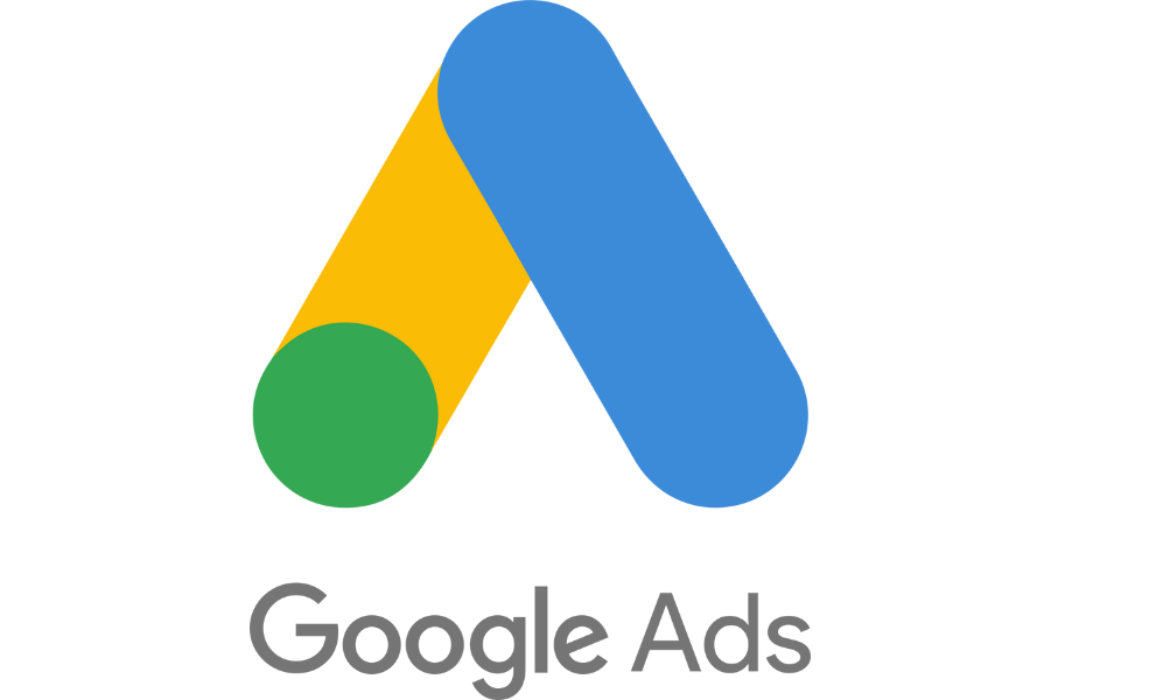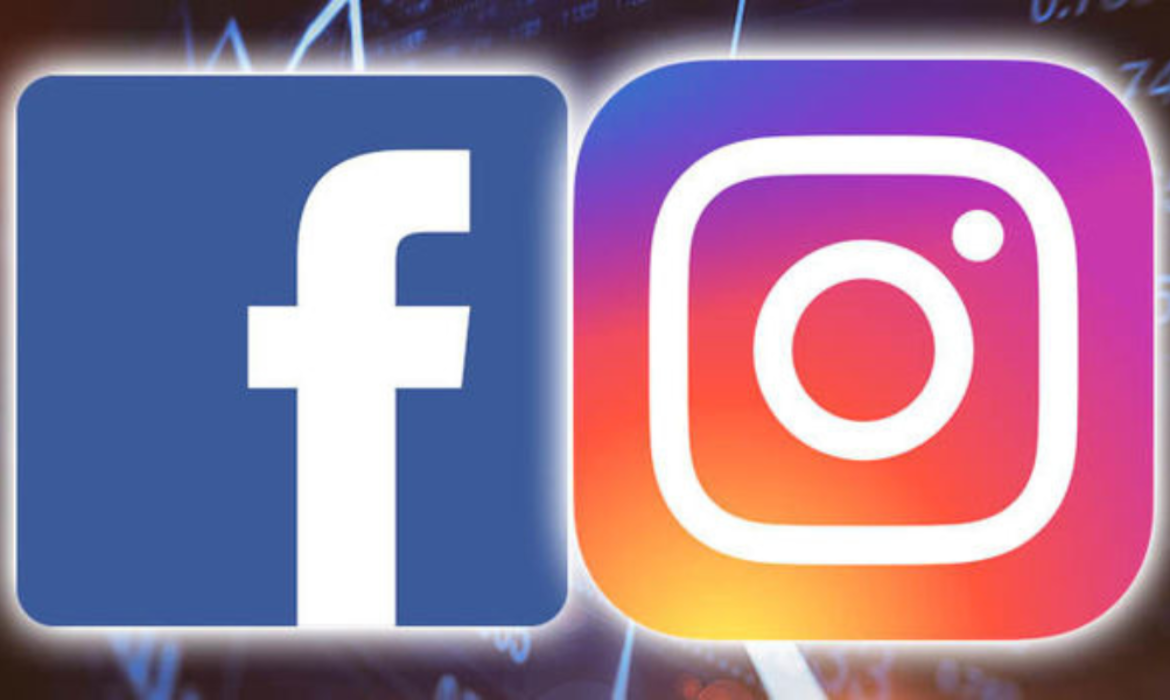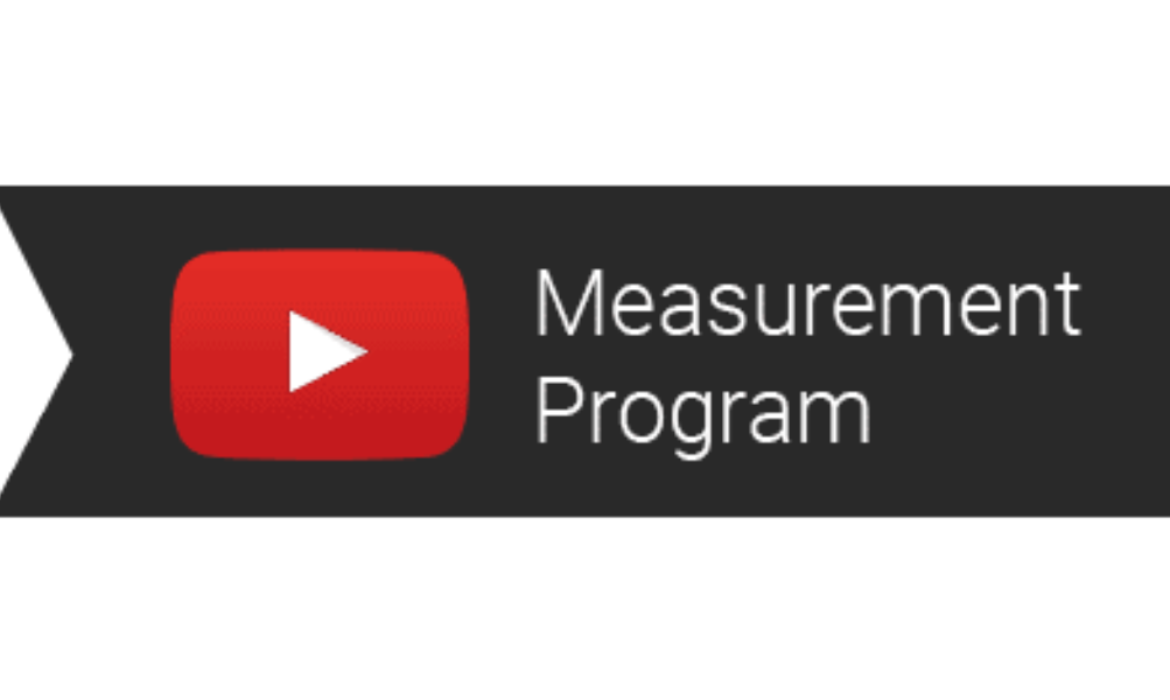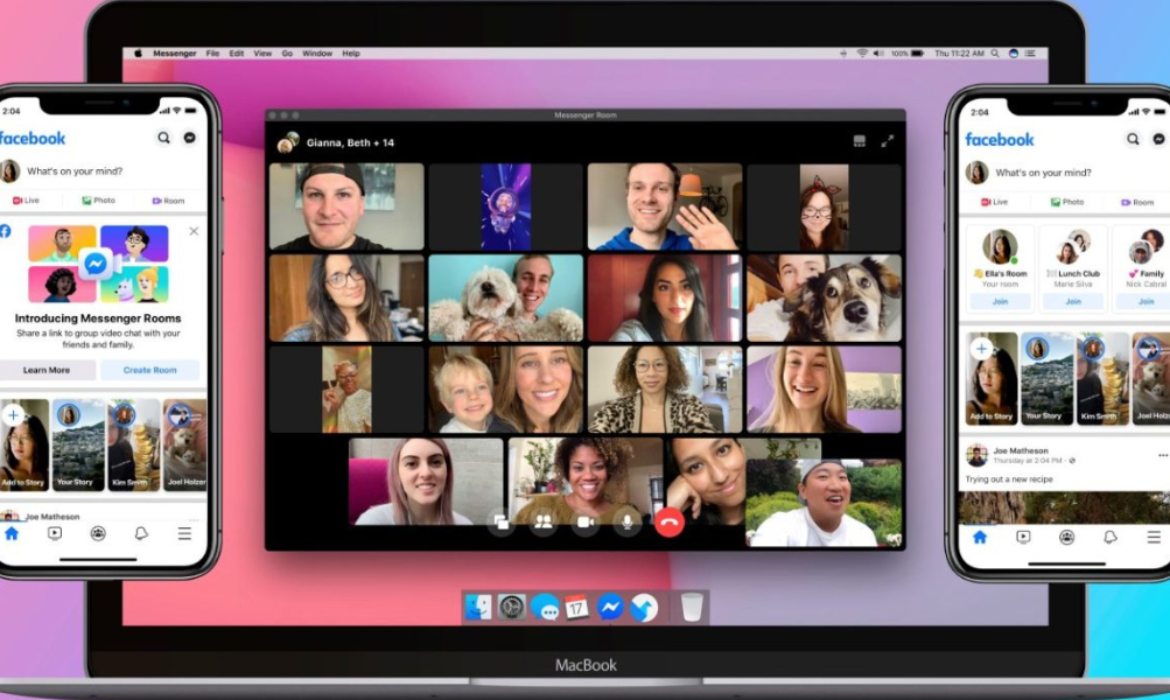Publicis Groupe’s Prashant Nandan Unveils Strategies for Connected TV Trends
Prashant Nandan, Senior Vice President of APEX at Publicis Groupe, is an experienced leader with over 15 years in digital marketing and advertising. With a deep understanding of go-to-market strategies, emerging media, and data-driven solutions, he unlocks business potential in the digital landscape. He is a visionary leader driving impactful results with proficiency in client servicing, media planning, programmatic, and more.
In this exclusive and captivating interview, he discusses effective strategies for Connected TV, transparency and Ad fraud, adapting to market dynamics, and embracing the Metaverse with AI.
Can you tell us about your journey and experience in creating go-to-market strategies across various digital channels?
My journey has taken me across mountains and oceans, through trials and triumphs, shaping me into a dreamer, a doer, and a believer in the power of determination. The digital world can be overwhelming, so I help connect businesses to digital ideas. My job spans the core areas of intelligence, investment, partnership, and innovation strategies for digital agencies and clients.
Creating go-to-market strategies: –
Each brand and market is unique, so it’s important to tailor our go-to-market strategy based on specific business goals, target audience, and industry dynamics. We regularly evaluate and refine our strategy to ensure it aligns with the brand’s evolving needs and market conditions. We help brands craft compelling and consistent messaging that resonates with the target audience and further tailor the messaging to each channel’s unique characteristics while maintaining a cohesive brand voice and identity. Adapting to changing market dynamics, we stay agile and capitalize on emerging opportunities. We are always open to experimenting with new channels or tactics based on data-driven insights and feedback from the target audience.
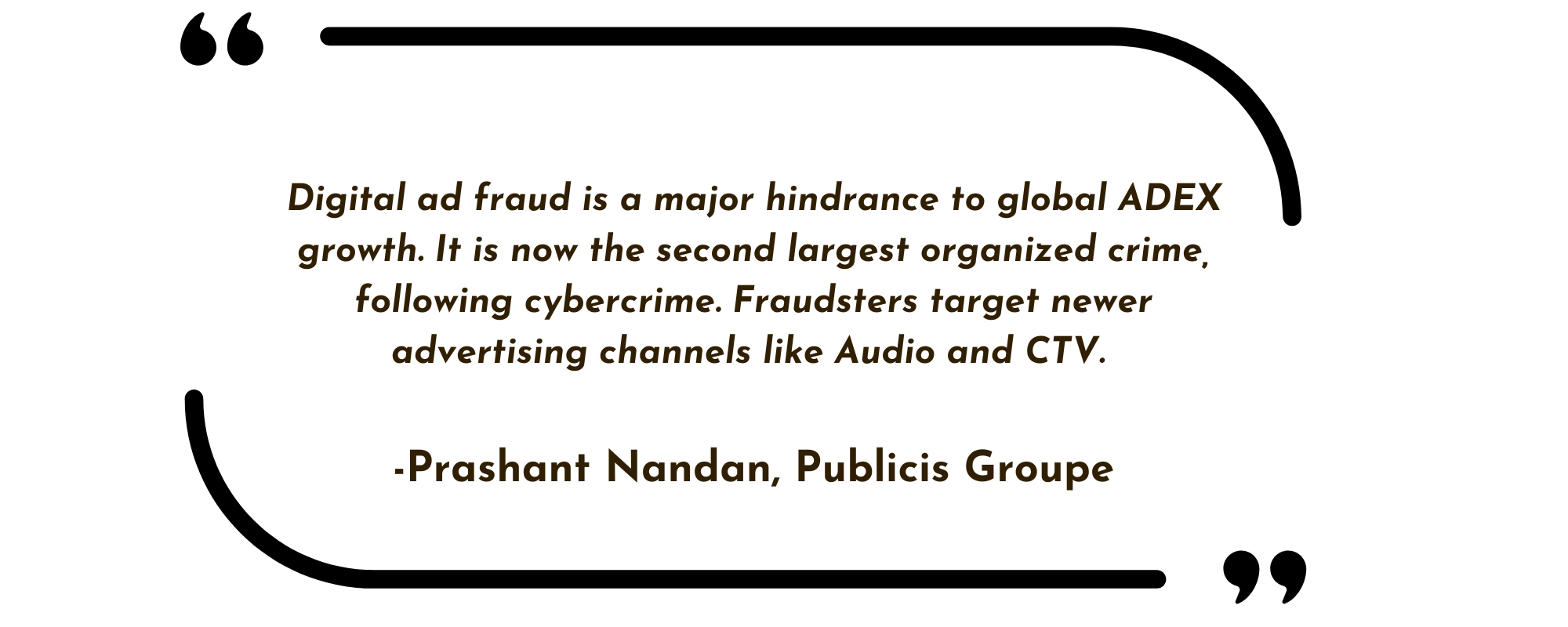
How do you determine the most effective mix of digital channels for a particular client or campaign?
Determining the most effective mix of digital channels for a particular campaign or client requires a data-driven approach. Here are some steps to consider:
- Clearly articulate the specific goals and objectives of the campaign. Whether it’s brand awareness, lead generation, sales conversion. Having a clear understanding of what brands want to achieve, will guide our channel selection.
- Develop a deep understanding of your target audience’s demographics, behaviours, preferences, and digital habits via different planning tools & primary/secondary research.
- Map out the customer journey from awareness to conversion. Identify touchpoints where our target audience interacts with digital channels throughout their decision-making process. Select channels that can effectively reach and engage our audience at each stage of the journey, ensuring a cohesive and seamless experience.
- Assess the strengths and capabilities of different digital channels. Consider factors such as audience reach, targeting capabilities, ad formats, pricing models, and performance metrics to evaluate how well each channel aligns with our campaign goals.
- Review past campaign data, industry benchmarks, and case studies to understand the performance of different digital channels in similar campaigns or industries.
- Manage the campaign budget and allocate resources based on the potential ROI of each channel. Evaluate the cost-effectiveness of channels by comparing factors such as CAC (Cost per customer acquisition), Cost per lead (CPL), and conversion rates. This analysis will help us optimize our budget allocation and prioritize channels that deliver the best return on investment(ROI).
- Implement robust brand safety, ad fraud, tracking, and analytics systems to monitor the performance of each channel.
How is your experience working with regional and global markets, and how do you adapt your strategies to different cultural contexts and market dynamics?
Working with different regional and global teams has given me exposure to diverse customer preferences, behaviors, and market trends. This experience provides valuable insights and learning opportunities, enabling me to refine our digital products, services, and marketing strategies. Engaging with different cultural contexts and market dynamics often fosters innovation and creativity, leading me to develop unique solutions and approaches that cater to specific client needs. I have learned to be adaptable and responsive to changing market dynamics, continuously monitoring client/internal stakeholder feedback, market trends, and the competitive landscape. This allows for timely adjustments to strategies, pricing, or product offerings to stay relevant and competitive.
What measures do you take to ensure that the programmatic campaigns are transparent and free from ad fraud?
Digital ad fraud is a major hindrance to global ADEX growth. It is now the second largest organized crime, following cybercrime. Fraudsters target newer advertising channels like Audio and CTV. The recent ICEBUCKET operation, exposed by White Ops, revealed a significant threat in the CTV space. By spoofing IP addresses of 2 million devices across 30+ countries, fraudsters made marketers unknowingly purchase CTV ad space that was served to bots. Additionally, DoubleVerify uncovered “BeatSting“, the first large-scale ad impression fraud scheme in digital audio advertising.
To combat ad fraud, all stakeholders, including advertisers, supply-side partners, device manufacturers, and server-side ad insertion, must be vigilant and implement solutions that address app fraud, device spoofing, Server-side Ad Insertion (SSAI) manipulation, non-stop ads, and malware-hijacked CTV devices. Here are tactics that advertisers can put in place to protect themselves.
- Bring a third-party vendor like Double Verify, Integral Ad Science, White Ops, Moat etc that detects fraud pre-bid level for protection against Digital ad fraud.
- Monitoring the location and device for all ads interaction & stick to premium inventory.
- All parties buying & selling video inventory should follow IAB guidelines, for CTV/OTT known as IFA ( Identifier for Advertising (IFA) series).
- Build a clean supply chain and remove the middlemen selling ad inventories.
- For Brand safety, advertisers should use keyword blocking, category blocks like sensitive, and unprofessional content, and work with the third party at the pre-bid level for brand safety.
- Pre-Bid filter of brand safety for checking App star ratings, age ratings, and store categories.
- In brand safety “Add blocking” should be available on all ad inventories to prevent ads from serving next to risky content.
- Give preference to programmatic inventory enabled with app-ads.txt.
- Avoid audience extension and long-tail “no-name” apps unless 100% transparent tracking and favorable terms and conditions are in place.
- The stringent clause at IO (Insertion order) for all level report transparency.
Can you explain the key differences between Connected TV and traditional TV advertising, and how these differences impact your go-to-market strategies?
The TV and digital industry use specific terms, like traditional/linear TV, OTT, and CTV. Here’s how to differentiate them.
| Linear TV or Traditional TV refers to the traditional method of content delivery where TV programs are only available at scheduled times. These programs are delivered by broadcast, cable, or satellite.
|
OTT refers to the delivery of on-demand video content through the internet by companies like YouTube, Netflix, Prime Video, and others. It allows viewers to watch their favorite shows anytime, bypassing traditional TV platforms such as cable and satellite. | CTV, or Connected TV, is a new viewing device that combines the advantages of traditional TV (shared viewing on a large screen) with digital streaming platforms (on-demand access to diverse content delivered via the internet).
|
Connected TV (CTV) devices like smart TVs, gaming consoles, and streaming sticks (such as Chromecast, Apple TV, Roku) enable users to access and display two types of content on a large screen:
1) Internet-delivered programming from broadcast and cable TV networks.
2) Digital-only streaming content from platforms like YouTube, Netflix, Prime Video, and Hotstar.
Go-to-Market Strategy for CTV: To achieve incremental reach, it is beneficial to combine Linear TV and CTV strategies. Linear TV maintains a strong reach among the TV-viewing population in India, and the hybrid viewing pattern is expected to persist for years. By merging the teams responsible for linear and connected TV buying, the goal of reaching viewers on any screen can be effectively accomplished.
Here are a few ways to do it:
- First, to drive incremental reach use Automatic Content Recognition (ACR) data to segment households that were exposed to the linear TV campaign and those who had not been exposed.
- Next, target non-exposed households with ads on CTV.
- Balance your frequency by targeting light TV viewers and cord-cutters more heavily than heavy TV viewers.
- ACR can identify households watching the competition ads and target them on different digital devices.
- Combine second screen targeting (Second screening” is a term for when viewers are watching television but are also using a secondary electronic device during that time) with your TV campaign.
- CTV ads are served programmatically so you can target audiences that have streamed content by genre, movies, TV series, actors, or directors.
Connecting linear and CTV ecosystems benefits advertisers with quality inventory, cross-screen audience reach, and effective measurement and attribution.
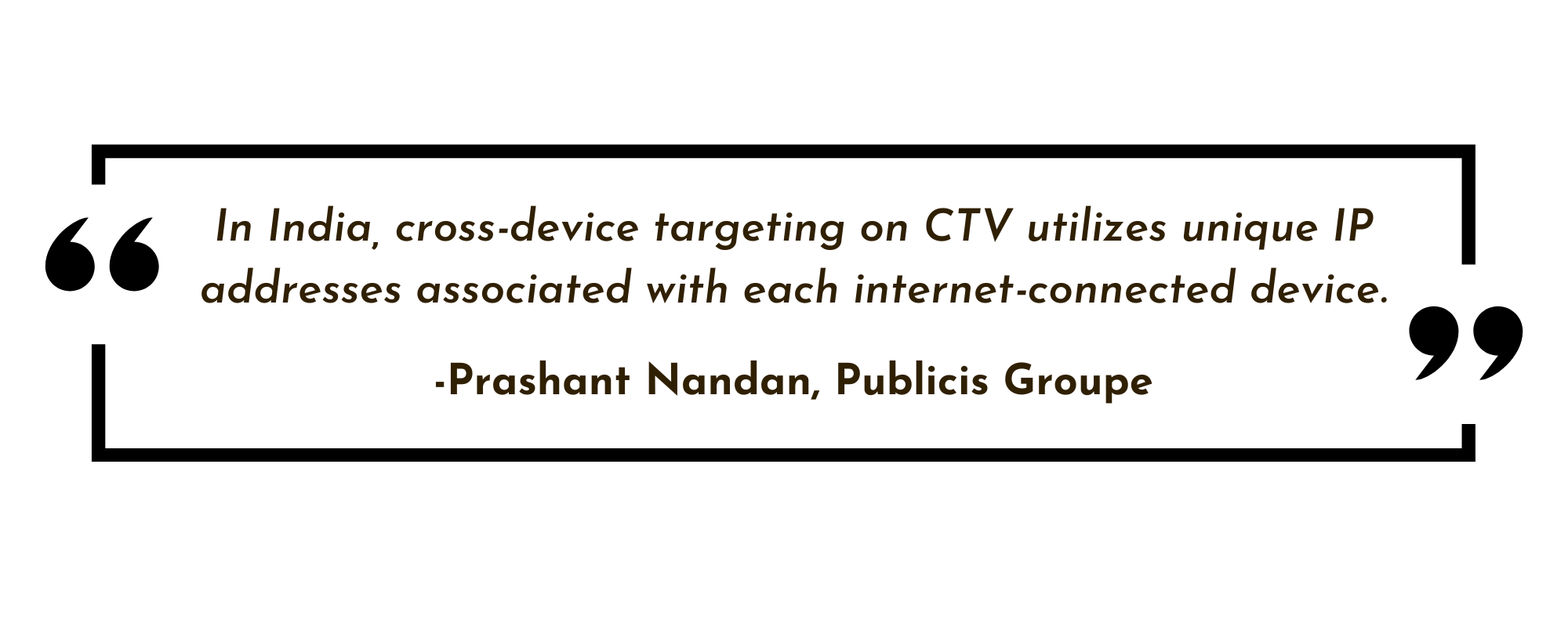
How do you manage cross-device targeting and attribution in your Connected TV?
In India, cross-device targeting on CTV utilizes unique IP addresses associated with each internet-connected device.
- Ad-tech companies employ diverse methods to identify IP addresses of devices accessing CTV content, which serve as unique identifiers for each device.
- Ad-tech companies collect and maintain databases of IP addresses associated with specific devices or households.
- Ad-tech companies utilize device graphs, which are databases or platforms that link multiple devices to the same individual or household. These graphs combine data points like IP addresses, cookies, device IDs, and other identifiers to create a comprehensive view of cross-device behavior. By analyzing shared IP addresses and Wi-Fi network connections, patterns and connections can be assessed to identify devices likely used by members of the same household.
- Once devices belonging to a household or individual are linked through IP address matching, brands can target specific ads to those devices across CTV platforms. Advertisers can leverage audience segmentation and targeting criteria, such as demographics, interests, and browsing behavior, to deliver relevant ads to the identified devices.
It’s important to note that IP address-based targeting for cross-device advertising has limitations. Dynamic IP addresses, shared networks, and privacy measures like virtual private networks (VPNs) can reduce the accuracy and precision of device-to-household mapping.
Measuring attribution on CTV : In this evolving stage, advertisers employ multiple approaches such as ad server reporting, incremental testing, panel surveys, and other data sources to refine measurement methodologies. These efforts aim to gain a comprehensive understanding of the attribution and effectiveness of CTV campaigns.
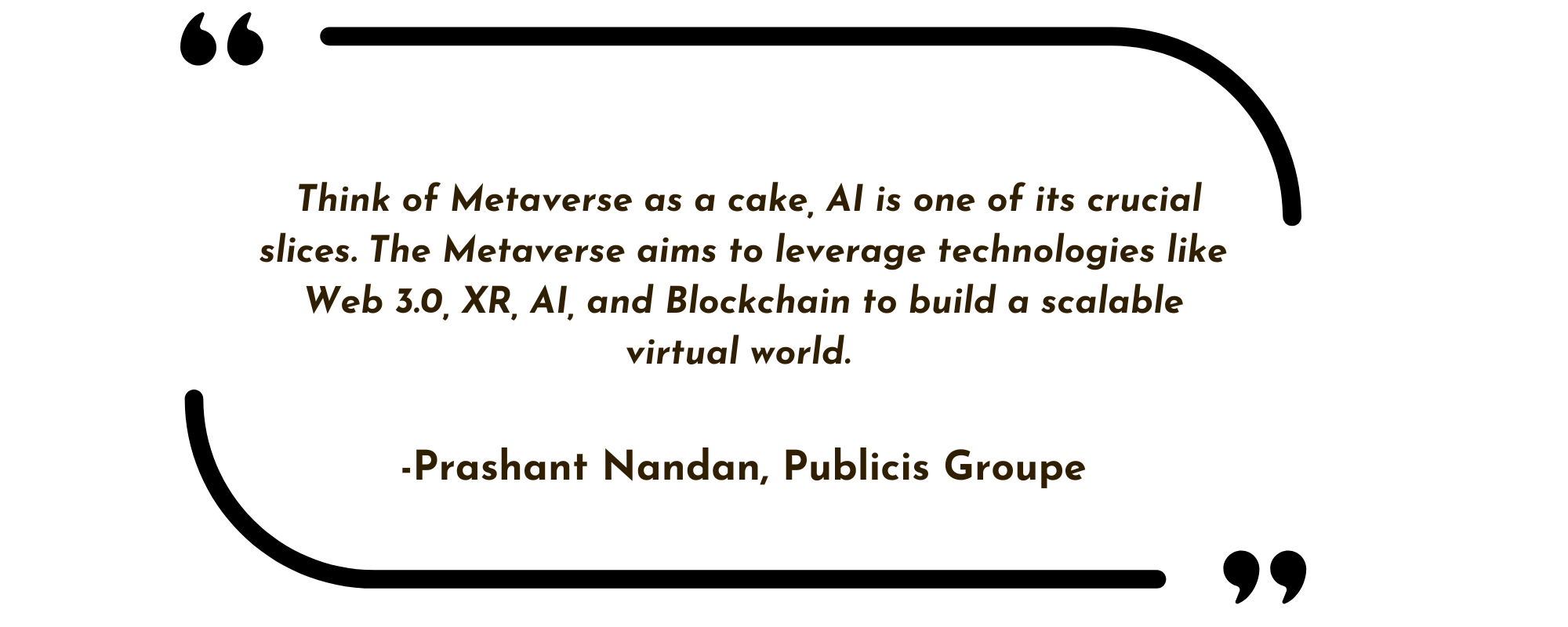
What are some key trends you see emerging in the Connected TV and how do you plan to capitalize on these trends in your strategies?
The cord-cutting audience is expected to grow. In the next 5 to 7 years, smart televisions are projected to become the norm in India, offering on-demand content, music streaming, video calling, and personalized recommendations. These TVs will also enable social interactions, co-watching, and content sharing. Additionally, smart TVs will embrace portability through cloud computing, allowing users to enjoy their favorite content anytime, anywhere.
In the future, TVs will go beyond traditional viewing, with OEMs adding services like gaming and health & fitness. Samsung, for example, has introduced a gaming hub on its smart TVs, allowing users to play games without a console or PC. Remote-controlled TVs will become outdated as voice-based and XR-controlled smart televisions gain prominence. While shopping directly on TV interfaces is still developing and limited to QR codes, tech platforms like Amazon and Google are experimenting with shoppable content ads.
CTV platforms are increasingly integrating with data management platforms (DMPs) and customer relationship management (CRM) systems, empowering advertisers to leverage first-party and third-party data for enhanced audience targeting and campaign effectiveness.
What is your perspective on the relationship between AI and the Metaverse? Do you believe AI is dominating or overshadowing the development of the Metaverse?
If we think of Metaverse as a cake, AI is one of its crucial slices. The Metaverse aims to leverage technologies like Web 3.0, XR, AI, and Blockchain to build a scalable virtual world. While AI has become a critical technology, predictive AI predates generative AI, utilizing statistical models, data analysis, and machine learning algorithms for future predictions. However, the Metaverse won’t achieve mainstream adoption overnight, as it faces challenges that need to be addressed. Concurrency and latency are foundational issues that must be solved.
Facebook, for instance, believes the Metaverse is at least 10 years away from entire operation due to these challenges. AI will play a facilitative role in the growth of the Metaverse, automating tasks such as creating and designing virtual environments, as well as aiding in content creation like 3D modeling and natural language processing.
Google Introduces New Ad Tools, YouTube Short Ads Are Coming
Google has announced numerous new ad tools at its Google Marketing Live event, including new ad options for YouTube Shorts, new layouts for Responsive Display Ads, improved analytics, and new ad testing options.
YouTube Shorts
YouTube has been teasing ads on Shorts since last October, but is now progressively rolling it out worldwide.” Google has integrated Shorts advertising into its Video Action and App campaigns. Brands will be able to connect product feeds to their Shorts promotions and make video ads more shoppable.
This could eventually be integrated into regular Shorts clips, enabling creators to monetize their content better. Although it isn’t available yet, the new display could prove valuable for brands, as Shorts delivers more than 30 billion views daily. As quoted by 9to5Google, the company said,
“This is an exciting milestone for advertisers, and a key step on our road to developing a long-term YouTube Shorts monetization solution for our creators, which we’ll share more about soon.”

Image Credit: Google
Google Discover Feeds
Discover feeds are where people scroll through their favorite personalized content for ideas and inspiration. Though it is a lesser used Google app, the new video ad options could help to connect with users and offer more compelling and engaging ad experiences.

Image Credit: Google
Display & Video 360 ad
Google’s also updating its Display & Video 360 ad options and getting new visual shopping ads.
Advertisers will soon be able to add Connected TV campaigns to reach affinity, in-market, and demographic audiences across YouTube and other ad-supported connected TV apps. On the top-left corner, one can swipe through various images accompanied by various product details, such as prices and ratings. This might include information about loyalty programs.

Image Credit:9to5 Google
3D Models of products from merchants will also appear directly in search results, as Google claims 90% of Americans currently use or would consider using, AR for shopping.
Responsive Search Ads
Later this year, Google will roll out automatically created assets for responsive search ads, which should make ads more relevant.
“If you opt in, Google Ads will automatically create assets for you based on content from your landing pages and existing ads. The system will then display the best-performing combination of automatically created assets, and the assets you provide, to make your ads more relevant. The system will then display the best-performing combination of automatically created assets, and the assets you provide, to make your ads more relevant.”

Image Credit: Google
Mobile-First Layouts For Responsive Display Ads
All-new, mobile-first layouts will allow advertisers to showcase their brand on full-screen portrait ad inventory. In addition, Google is introducing scrollable ads and videos based on the product feed.
Performance Max Campaigns
Performance Max campaigns to help advertisers drive better results across Google’s channels and inventory They include A/B testing, campaign management, support for store sales goals to optimize for in-store sales, new insights, and explanations, including attribution, audience and auction insights, and optimization score and recommendations.
Google Insights
Google’s also adding new personalized trend data to its ad insights page to improve contextual understanding and targeting. They include three new reports- Attribution insights, Budget insights, and Audience insights.
Other New Advertising Features
Conversion Lift Test
Google is also bringing Conversion Lift tests directly in Google Ads and Display & Video 360. It will help to measure incremental conversions based on users and regions, and Search Lift tests will enable you to measure the effectiveness of YouTube campaigns at driving organic traffic to YouTube and Google.
Privacy-safe options for interest-based advertising and remarketing
There will be worldwide testing in Google Ads and Display & Video 360 later this year. These tests will incorporate signals from the new Privacy Sandbox APIs.
Ad Control Center
Earlier this month, Google previewed its Ad Control Center at its I/O Summit. People will be able to pick the types of ads they want to see more or less of and control how their data informs ads they see across YouTube, Search, and Discover.
There are several interesting new additions, but the new Shorts display option is the biggest. Users will be able to expand their reach with the rapidly growing Shorts audience. With the growth of TikTok, short-form video has become highly influential. Brands should take note of these options and work to find ways to make use of them in order to maximize appeal and resonance.
Interesting Read: Bridging The Gap: Is YouTube Unifying Linear And CTV Ad Buying?
Facebook Debuts Shops In Its Mobile App, Instagram Expands Checkout Feature

Facebook rolled out a shopping section ‘Facebook Shops’ to its main app across the U.S and expanded Instagram’s checkout feature.
The new section Facebook Shops allows users to browse product catalogs from businesses they like, discover new businesses and make purchases, all-in-one place, and without leaving the app. A similar feature ‘ Instagram Shops’ was introduced on its photo-sharing app last month.
The news follows the launch of Facebook Shops in May and on Tuesday it announced a couple of new e-commerce features within its flagship mobile app and Instagram. Businesses were already able to add product catalogs to their Facebook pages but there was no dedicated section inside the app for browsing the selections.
The company explained the rapid shift toward online shopping as a reason to foray into eCommerce.
“During the COVID-19 pandemic, the shift to online shopping has rapidly accelerated, with an estimated 85% of people worldwide now shopping online.
We want to make shopping easier for people and empower anyone, from an entrepreneur to the largest brand, to use our apps to connect with customers and grow their business.”
Here are the details that will help people to shop on the apps and tools to help businesses sell online.
Shop Till You Drop!
A new ‘Shop’ tab is introduced in the mobile app where businesses can showcase their products and customers can shop them in the app.
“Facebook Shop makes it easy for people to find products from businesses they love, discover new ones and make purchases, all in one place.”
It’s a significant step for Facebook’s eCommerce push, helping users to browse and purchase from shop-enabled Pages directly in the app. Presently, being tested in the US but Facebook said in the coming weeks it will be available to all eligible businesses.

New customization features will also be added to Facebook Shops that includes:
- New design layouts for featuring single products or groups of products in Shops
- Real-time preview of collections as they are designed
- The ability to automatically create Shops for new sellers
- New insights to measure results in Commerce Manager

Expanding Instagram CheckOut
Checkout allows users to pay for items directly inside the app and will soon be available to all businesses in the U.S after keeping the feature exclusive to certain partners for almost 18 months. Though there is a limitation,
To use checkout, businesses must have Shops and use Facebook Commerce Manager or our partners Shopify and BigCommerce. We’ll support more platform partners soon.
It will also provide an incentive by waiving the selling fees for businesses through the end of the year due to the current economic crisis.
Shop Using Messaging
Facebook added a new message option to the shop in order to connect the customers directly to the seller through Messenger, WhatsApp, or Instagram Direct.
“Messaging through Shops combines the in-store experience of being able to ask a salesperson questions with the convenience of online shopping.”

Customers can view the products in the chat and can easily share with friends and family for feedback before any purchase. This feature is now being tested on Messenger and Instagram Direct and will start testing on WhatsApp soon.

This will definitely boost Facebook’s dominant presence in messaging with its eCommerce capacity, providing compelling business opportunities as people are regular users of these messaging apps.
Live Facebook and Instagram Shopping
Another promotional option is Facebook and Instagram live shopping. This means businesses can sell products during a live stream.
“Facebook Live Shopping includes new features to help businesses easily set up a live experience featuring products from their Shop and sell directly from the video.”
Instagram Live Shopping is available to all businesses and creators using checkout in the US.

Video is the most engaging type of content and during the lockdown during the pandemic, the viewership of Facebook live streams had risen 50% since January as people looked for various ways to stay connected and entertained.
The global lockdown has provided a significant opportunity to Facebook’s eCommerce business as more people shifted to online shopping. The social network will soon become an essential part of our day-to-day lives as it prepares to build a commerce eco-system within its own network.
YouTube Reorganizes Its Measurement Program With Five New Partners
Google made notable changes to the line up of partners of its YouTube Measurement Program(YTMP) that debuted in 2017 to give advertisers access to trusted and independent solutions for driving and tracking the marketing performance of the video site.
Google made some tweaks to how it classifies partners in the YouTube Measurement Program and welcomed new partners to the program or specific categories. YouTube has made it easier for advertisers to search for the right service provider for their needs.
YouTube added five new partners – Channel Factory, Integral Ad Science, DoubleVerify, Sightly, and VuePlanner to the program. Existing partners include Pixability, Zefr, Tubular Labs, and Wizdeo -though it has dropped one of its founding partners who is no longer on the list ‘Open Slate’. Apparently, the brand safety company is at a contractual standoff with Google.
AdAge reports that Openslate refused to sign the new agreement with Google. It believed that the contract would limit what it can report to the clients when ads ran next to videos with sensitive or harmful content on YouTube like hate speeches, illegal substances, or violence.
Under new terms, without Google’s approval, OpenSlate would not be able to inform the client that includes Nestle, GroupM, and Procter & Gamble – if their ads run next to YouTube channel that has historically shared violent or inappropriate content.
OpenSlate told in an e-mail statement to AdAge,
“Advertisers rely on OpenSlate’s independent, third-party measurement to ensure they are running in suitable environments.”
It further says,
“Google is a valued partner and we endeavor to resolve our differences,”
A Google spokesperson told AdAge,
“We’re excited to expand the YouTube Measurement Program and look forward to working with the nine partners who have already signed on. We also remain open to any other third parties who help meet our clients’ needs joining the program in the future.”
After the reorganization, advertisers can search by services under the newly created categories: brand suitability and contextual targeting, content insights, and brand safety reporting. Partners will be classified and sorted based on these categories.
As outlined on the YTMP website, Channel Factory, Integral Ad Science, Pixability, Sightly, VuePlanner, and Zefr were added in the Brand Suitability and Contextual Targeting category while DoubleVerify and IAS were added to the Brand Safety Reporting category. Meanwhile, Pixability, Tubular Labs, and Wizdeo were added to the Content Insights category.
Also Read: Everything You NEED TO KNOW About Advertising On YouTube In 2020
As quoted in Adexchanger, David George, CEO of Pixability, one of the first companies to join in 2016 said, the time was ripe for a revamp.
“Simply put, there’s demand in the market from brands and agencies that want to work with third parties,”
YouTube is growing exponentially in terms of engagement and ad revenue. Although due to coronavirus led volatility, YouTube is facing a significant decline in CPM’s in some cases, however, YouTube drove $15 billion ad revenue for Alphabet in 2019.
Tony Marlow, CMO at Integral Ad Science said,
“For a platform that generates over 500 hours of new content every minute, it makes sense that they are constantly evaluating the efficiency of their programs.”
IAS has been providing brand safety verification since 2018 but it wasn’t under the measurement partner program until now. The measurement program also offers access to the participating partners to alpha and beta programs and additional resources.
Theresa Go, Pixability’s VP of platform partnerships said,
“There is an undercurrent of technical support we get through the program. We’re able to leverage Google to make sure we’re providing the best products we can in the market.”
Facebook Rolls Out Video Chat Messenger Rooms To Beat Zoom And The Likes
- Facebook announced 50-person video chat rooms called Messenger rooms.
- Regardless of whether participants have a Facebook account, they can participate in the calls.
- Messenger Rooms are an answer to Zoom and Houseparty for Pandemic.
- Messenger Rooms will roll out this week in a few countries and the rest of the world next week including the U.S.
Video calling services have seen a sharp rise during the coronavirus crisis and the use of video calling on Facebook Messenger has doubled in the coronavirus affected areas. On Friday, Facebook CEO Mark Zuckerberg delivered a live stream to announce the company’s retooled video products for users to connect while at home under quarantine. The video update perfectly fits Facebook advertising plans that focus on e-commerce.
As many countries issued stay-at-home orders, rival apps Zoom witnessed a drastic growth in the active users to 300 million in April, and Houseparty, owned by Fortnite-maker Epic Games, was downloaded more than 2 million times in the start of March. Facebook has seen the success of Zoom, the video conferencing sites popular among the companies that have sent employees to work-from-home. The biggest product launch ‘Rooms’ will be created via Facebook Messenger which allows 50 people to hang out at a time. The company plans to add the feature to Instagram, Whatsapp and it’s portal-video calling devices soon.
Key features of Messenger Rooms:
- People will be able to keep their room private, block unwanted participants, and invite people who are not on Facebook.
- Participants can use AR filters and change the background real-time
- Discoverable rooms will be listed at the top of the feed.

Image Credit: BBC
However, messenger rooms are not end-to-end encrypted like Group Facetime or WhatsApp call. Stan Chudnovsky, VP of Messenger said on the blog,
Room calls are not end-to-end encrypted, but Facebook says it does not view or listen to calls. The creator of a room can remove participants at any time, and rooms where illicit behavior is taking place can be reported to Facebook. (WhatsApp video calls are end-to-end encrypted, offering an extra layer of protection to users.)
Summary of Other Updates from Facebook
- WhatsApp will accommodate from four to eight participants in the video group calls making it a suitable competitor to Zoom.
- Facebook Live and IGTV: Facebook is creating advertising that fits in this environment especially in the areas that are popular among consumers like home cooking, fitness, and others. It will be open for business and more e-commerce activities will take place. 800 million people watch live streaming on Facebook and Instagram.
- Donate Button on Live videos: This helps musicians, artists, people, and activists can raise funds for causes during the coronavirus outbreak.
- Live via Audio only: with more musicians doing live concerts on Facebook Live, you can listen in case you cannot watch it or want to save on data.
- Instagram Live On Web: You can watch live videos related to any activity or product from the desktop.
- Portal Live: One of Facebook’s hardware projects that have seen a slow adoption but with the COVID-19 crisis the sales increased tenfold. You can go to Live to the pages and Groups devices from Portal devices and can also create interactive content for customers and communities.
- Facebook Dating Video Chat: It is in the nascent dating service. Facebook dating is a virtual meet up and does a video chat with matches on Facebook first.
Facebook is going to report quarterly earnings next week and it has already said that the revenue has been negatively affected due to the coronavirus crisis as advertisers have pulled back on spending and online ad auction prices have been reduced. According to eMarketer Facebook ads and the amount it earns from each unit sold has decreased by nearly 50% in some categories.
Debra Aho Williamson, principal analyst at eMarketer, in her note said,
“Those losses will be made up for by gains in categories that increased their use of Facebook advertising at the end of March, either to market products or services aimed at people staying at home, or to take advantage of drastically lower ad costs.”


